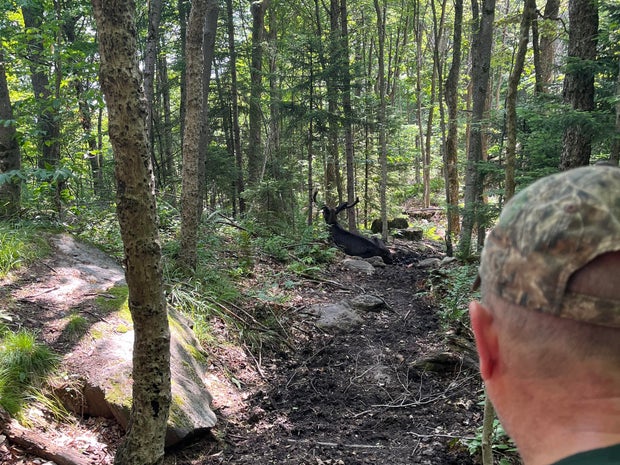A bull moose whose lingering presence around an Adirondack mountain hiking trail this summer forced its closure was euthanized after showing signs of severely deteriorating health, New York environmental officials said Thursday.
The Goodman Mountain trail in the Horseshoe Lake Wild Forest had been temporarily closed since June 6 after the moose began exhibiting “unusual behaviors” and staying on or around the trail near the summit. The moose, about 6 feet tall at the shoulder, was first spotted by the trail in May and efforts coax it away were unsuccessful.
Wildlife biologists and a state veterinarian who visited the trail near Tupper Lake, New York, on Wednesday saw that the moose was severely emaciated and showed other signs of advanced disease. They determined euthanasia to be the most humane course of action, given the animal’s condition and low likelihood of survival, according to the state Department of Environmental Conservation.
“While we never take such actions lightly, humane euthanasia is sometimes the most responsible course of action. In addition, information gathered from this animal will help DEC better understand and manage moose in New York,” Jacqueline Lendrum, director of the agency’s Division of Fish and Wildlife, said in a statement.
New York State Department of Environmental Conservation
Researchers have estimated that the moose was about 4 years old.
Dr. Jennifer Bloodgood of the Cornell College of Veterinary Medicine said a necropsy will be performed to help authorities understand the cause of the moose’s decline and to provide more information on threats to the large mammals in New York state.
Officials said forest rangers will continue patrolling the area and the hiking trail will emporarily tremain closed while experts “complete a study of the area to fully evaluate evidence of the foraging behavior and habitat range of this animal.”
The state’s moose population was wiped out in the 1800s but has gradually grown from animals that wandered in from other northern states and Canada starting around 1980. There might be roughly 700 moose in the Adirondack region.
The DEC said staff regularly respond to situations related to moose.
“Most situations do not need intervention; however, when wandering animals like moose or bear show up in unusual places, DEC’s…
Disclaimer
We strive to uphold the highest ethical standards in all of our reporting and coverage. We 5guruayurveda.com want to be transparent with our readers about any potential conflicts of interest that may arise in our work. It’s possible that some of the investors we feature may have connections to other businesses, including competitors or companies we write about. However, we want to assure our readers that this will not have any impact on the integrity or impartiality of our reporting. We are committed to delivering accurate, unbiased news and information to our audience, and we will continue to uphold our ethics and principles in all of our work. Thank you for your trust and support.
Website Upgradation is going on. For any glitch kindly connect at 5guruayurveda.com




